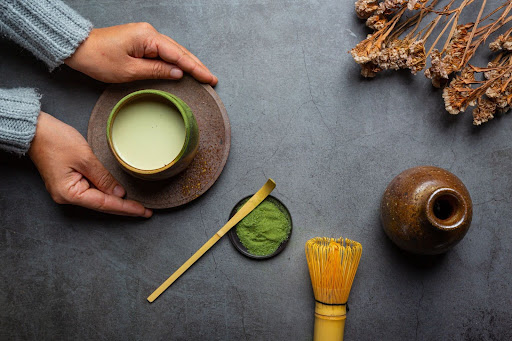Unlocking the Secrets of Japanese Matcha Tea: From Preparation to Health Benefits

In the realm of tea culture, Japanese matcha holds a revered status. Its vibrant green hue, distinctive flavor, and rich cultural heritage have captivated tea enthusiasts worldwide. Beyond its delightful taste, matcha offers a myriad of health benefits, making it more than just a beverage; it’s a holistic experience.
Join us on a journey as we delve into the secrets of Japanese matcha tea, from its meticulous preparation to its profound impact on health and wellness.
Understanding Matcha: A Brief Overview
Matcha, meaning “powdered tea,” traces its origins back to ancient Japan, where it was first cultivated and consumed by Buddhist monks seeking clarity of mind during meditation.
Unlike other types of tea, matcha is made from shade-grown tea leaves, which are carefully harvested, steamed, dried, and ground into a fine powder using traditional granite stone mills.
This meticulous process preserves the tea’s vibrant color and nutrient profile, making matcha a potent source of antioxidants, vitamins, and minerals.
The Preparation Ritual: A Symphony of Tradition and Precision
Central to the matcha experience is its preparation, which follows a time-honored ritual known as the Japanese tea ceremony or Chanoyu. This ceremonial practice emphasizes harmony, respect, and mindfulness, inviting participants to engage all their senses in the tea-making process.
To prepare matcha, one begins with a bamboo scoop, or chashaku, to measure the desired amount of powdered tea into a bowl, or chawan. Hot water, typically heated to around 175°F (80°C), is then carefully poured over the matcha powder.
Using a bamboo whisk, or chasen, the tea is skillfully whisked in a rapid, circular motion until a frothy layer forms on the surface, releasing its aromatic scent.
This meticulous preparation not only enhances the flavor and texture of the tea but also serves as a meditative practice, fostering a sense of tranquility and mindfulness in the participant.
Each step is imbued with intention, transforming the act of making tea into a profound expression of art and culture.
Exploring the Health Benefits of Matcha: Nature’s Elixir in a Cup
Beyond its ceremonial significance, matcha boasts a remarkable array of health benefits, earning it the title of “superfood” in modern wellness circles. Packed with antioxidants, including catechins and polyphenols, matcha offers potent protection against oxidative stress, inflammation, and chronic disease.
Studies have shown that regular consumption of matcha may help reduce the risk of heart disease, improve brain function, and support weight loss by boosting metabolism and promoting fat oxidation.
Moreover, matcha contains a unique amino acid called L-theanine, which induces a state of relaxed alertness, often referred to as “calm focus.”
This synergistic combination of caffeine and L-theanine provides sustained energy without the jitters or crashes commonly associated with coffee consumption, making matcha an ideal choice for those seeking a balanced and sustained energy boost throughout the day.
Furthermore, matcha is rich in chlorophyll, the pigment responsible for its vibrant green color, which helps detoxify the body by eliminating heavy metals and toxins.
Additionally, matcha contains vitamins A, C, E, and K, as well as essential minerals like potassium, calcium, and magnesium, supporting overall health and vitality.
Embracing Matcha as a Lifestyle: Tips for Incorporating Matcha into Daily Routine
Whether enjoyed as part of a traditional tea ceremony or incorporated into modern recipes, matcha offers endless possibilities for culinary creativity and wellness enhancement. Here are some tips for incorporating matcha into your daily routine:
- Morning Ritual: Start your day with a soothing cup of matcha latte or a refreshing matcha smoothie to kickstart your metabolism and boost mental clarity.
- Midday Boost: Combat afternoon fatigue with a ceremonial matcha break, allowing yourself to pause, breathe, and savor the moment.
- Culinary Delights: Experiment with matcha-infused recipes, such as matcha pancakes, matcha oatmeal, or matcha-infused desserts, to elevate your culinary creations with a touch of antioxidant-rich goodness.
- Mindful Moments: Use matcha preparation as an opportunity to cultivate mindfulness and presence, turning everyday tasks into moments of reflection and gratitude.
- Social Connection: Share the joy of matcha with friends and loved ones by hosting a matcha-tasting party or attending a virtual tea ceremony together, fostering connection and community through shared experiences.
Conclusion
In a world filled with hustle and bustle, Japanese matcha tea stands as a beacon of tranquility and nourishment. Its journey from leaf to cup embodies centuries of tradition and craftsmanship, offering more than just a delightful taste—it’s a portal to mindfulness and vitality.
Whether you choose to steep yourself in the serene ambiance of a traditional tea ceremony or infuse your modern lifestyle with its vibrant green essence, matcha has the uncanny ability to elevate the ordinary into the extraordinary.
So, why not take a moment to unlock its secrets and embark on a journey of flavor, tradition, and well-being? Embrace the art of living well with each sip, and let the spirit of matcha guide you toward a more balanced and harmonious existence.



